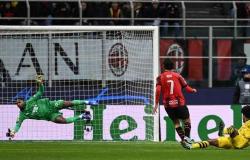18.04.2024 – 07.01 – Once Squero Panfilli; place of cafalque makers and coopers, of shipwrights and carpenters. Then Piazza dei Carters; place of Old Customs and the continuous passage of carts full of goods. And finally Piazzetta della Evangelical Lutheran Church of the Augustan denomination. Even today, passing by the Liceo Giosuè Carducci, the square of today’s Largo Panfilli seems too small, too small for such a tall church. The bell tower stretches towards the sky, the sharp spiers reach out sternly towards the horizon. The white stone, softened by neo-Gothic shapes, is reflected in the black of the iron gates.
Once upon a time the Lutheran community, 1900 strong members on the threshold of the First World War, was one of the most important religious enclaves of Trieste.
Nowadays, in a city profoundly distorted by twentieth-century world conflicts, the Lutherans and the evangelical church remain one of the focal points of cultural activities – especially music, Bach docet – of the territory. Concerts, celebrations, events of all kinds. The body (of believers) may have weakened, but the soul is still alive.
We asked the Lutheran pastor Andrei Popescu to tell us a little about the current Trieste community, with a look at the religious and social characteristics of the Evangelical Lutherans.
What does it mean to belong to the Evangelical Lutheran community of the Augsburg confession?
Being Lutheran is equivalent, on a confessional level, to recognizing the seven ecumenical councils and the Augustan Confession of 1530 which, in turn, includes the previous councils.
Martin Luther’s movement was the first to develop, to transform itself into a Church; although Luther himself wanted to reform Rome from within, it is no coincidence that we speak of the ‘reformed’.
The Reformed in general relied on the word of the Bible; not about mysteries. For example, the Catholic Eucharist requires that the bread becomes the body and the wine the blood of Christ forever during the Eucharist; and this is why the hosts are kept in the tabernacle. In the case of the Lutherans the bread becomes simple bread again at the end of the ceremony.
There are therefore numerous points in common with the Catholic Church, but there are also elements that developed subsequently and were separate; for example, for us saints are exemplary people, but they are not to be venerated. Or we don’t address prayers to the Madonna, for example, her holiness is not a dogma for us. As a Lutheran I don’t see the need for intercessions.
In fact, we are sometimes defined as ‘Catholic Protestants’, because we place ourselves in the middle: we are between Catholics and Reformed, between the sense of the mystical, of the ‘feeling’ of the Catholics and instead the emphasis on the intellect of the Reformed.
What are the differences between Catholic priests and Protestant pastors?
I am in the middle, because I was ordained by the Lutheran Church of Sweden. While in Germany, following the birth of the Reformation, the Catholic bishops refused to ordain priests of the new movement, in Sweden the bishops also converted and therefore from the Protestant perspective they had full right to ordain, for the apostolic succession, their priests. It’s no coincidence that when I’m in Sweden they call me ‘priest’.
Furthermore, the priesthood is universal: we disciples of Christ are all priests. The Protestant pastor, unlike the Catholic church, is chosen as a representative, as a scholar who knows more about the history of the Bible and the Church. I, as a pastor, have more information and can therefore help the faithful. However, unlike what happens with Catholic priests, there is not a single reading of the Bible allowed.
In Germany, in turn, in the north we are called shepherds (Pastoren) and in the south ‘parish priests’ (Pfarrer). A need, especially decades ago, to distinguish oneself from German Catholics: the separation at the time was very strong, at the level of families and entire countries.
The Catholic priesthood also provides for a consecration during this mystery; the Protestant pastor, on the other hand, does not consider himself closer to God than the simple believer, but only a person who has more knowledge.
From a practical point of view, the Lutheran pastor can marry a man or a woman and have children; or even not getting married at all. In short, the choice is free and personal.
What is the weight of the German language in the Lutheran community?
Lutheran communities are historically all German-speaking, having originated in Germany. The community of Trieste has only been officially Italian speaking since the year 2000; previously it was German speaking. Following the First and Second World Wars, German native speakers progressively decreased and it was finally decided to choose Italian as the official language. However, worship is still practiced once a month in German. The same holidays are still linked to Germany and are less celebrated in Italy; for example Good Friday and Christmas Eve, both always celebrated in German.
What characterizes Lutheranism on a cultural level?
Characterizing elements of Lutheranism are culture and music. Here in Trieste the community has an excellent organist – Manuel Tomadin – who offers organ meditations in church every Wednesday until June, from 5.30pm to 5.50pm. Anyone who wishes can then leave an offering for the restoration of the organ; it is in fact an initiative aimed at recovering the ancient structure.
The organ turns 150 this year; like the church itself, after all. It had been restored forty years ago, but now needs a new update. There are very few people who know how to build organs nowadays; it is a difficult financial undertaking.
We also offer, following the example of similar initiatives in Germany, the possibility of adopting organ pipes. The name is included among the supporters of the restoration of the organ on a special plaque; ‘adopt’ means for example asking for your child’s name to be marked as a benefactor of the church, in exchange for an offering for restoration.
The organist is also trying to mobilize funds from the region from public and private bodies, but the procedures, from a bureaucratic point of view, appear complex.
There will also be a great musical meditation on May 5th, from 5.30pm to 6.30pm. An hour of music by Bach; if we want the best known ‘Lutheran’ of organ music.
What is the size of the Lutheran community in Trieste?
In Germany, if you are a member of a church, you automatically pay taxes for that specific faith. In turn, being a member of a community allows you to access the so-called “random”; for example at a church wedding. Therefore it is easy to know the real size of the community.
In Italy the 8×1000 allows greater freedom; for example, there are Catholics who allocate the quota to the Waldensians or the Lutherans. It is also possible in Trieste to provide an annual fee to the Lutheran community of Trieste and following this you are registered as a member. However, it is not certain that those who come to worship have paid the fee and vice versa; after all we also receive Methodists, Waldensians, Adventists, Catholics and Lutherans passing through the sacred services.
What is the weight of the linguistic element in the Lutheran community of Trieste?
In general, a large part of the community speaks the Italian language; even Germans who moved to Trieste often learn Italian. On the contrary, there are predominantly German-speaking communities in Italy; in Rome, in Milan… In Alto Adige the communities are only German speaking.
Is there still a Lutheran presence in Friuli Venezia Giulia and in the North East?
There was once a Lutheran community in Gorizia and in Istria in Pola; however, after the upheavals of the twentieth century, both communities disappeared. The evangelical Methodist church remains in Gorizia. In Croatia nowadays there is a Lutheran community in Zagreb for example. The oldest Lutherans in Italy date back to Venice, in 1650; then there is that of Trieste, the second oldest, around 100 years later. The church of Largo Panfili itself is the largest Lutheran place of worship in Italy.
What is the sense of ‘religious’ within the Lutheran community of Trieste?
In Germany my largest community had 850 members; however, of these only 15 attended worship. Here, however, between 15 and 25 usually come, although officially we are around 160. Therefore participation is greater, the community is much more cohesive and active. There is a strong sense of the ‘history’ of the community.
[Classe 1983, nato a Bucarest, Andrei Popescu ha compiuto gli studi di teologia in Germania, con un anno di studio a Roma. È stato poi praticante in Svezia, dove è stato ordinato Pfarrer Luterano. Pastore da sette anni, Popescu prima di giungere a Trieste gestiva tre comunità a Kassel, nel cuore della Germania.
La comunità evangelica luterana di confessione augustana ha sede in Largo Odorico Panfili n. 1; la chiesa è contattabile al numero 040 630168 e tramite mail a [email protected]]
[z.s.]
Tags: Communicate communities fifty years Lutheran church Trieste






